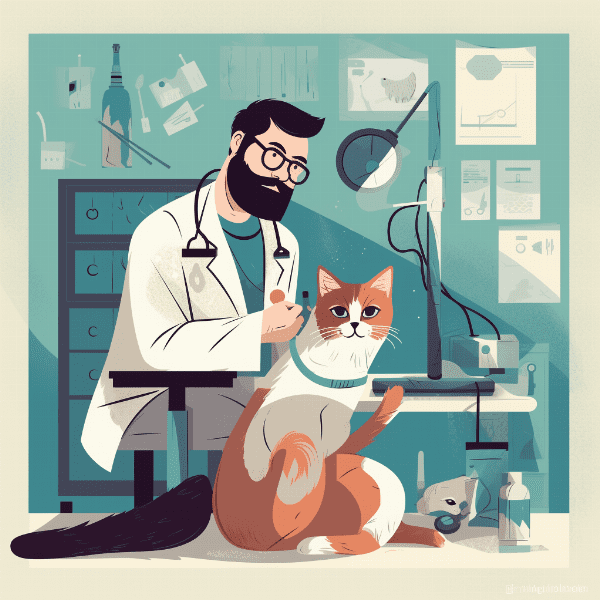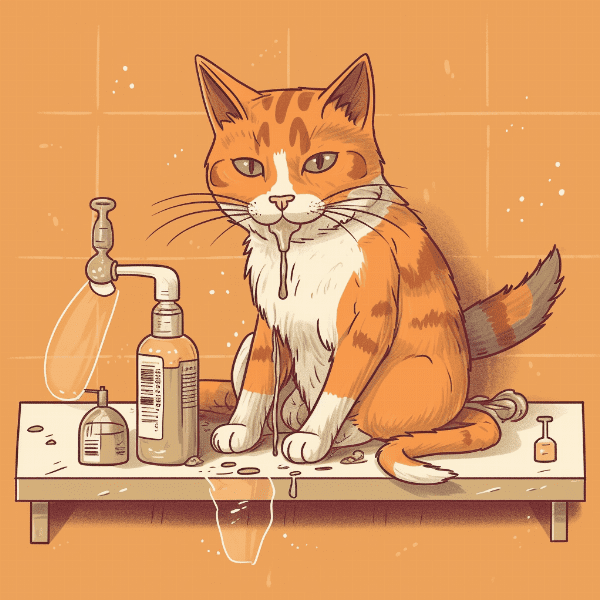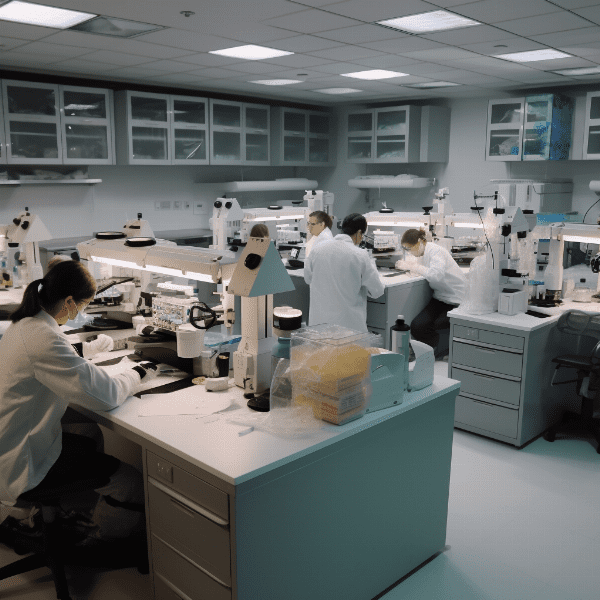Table of Contents
- Understanding Feline Bacterial Infection
- Common Bacterial Infections in Cats
- Recognizing Symptoms of Bacterial Infection in Cats
- Diagnostic Procedures for Feline Bacterial Infection
- Treatment Options for Feline Bacterial Infection
- Antibiotics for Cats with Bacterial Infection
- Home Care and Prevention of Bacterial Infection in Cats
- Potential Complications of Untreated Bacterial Infection in Cats
- When to See a Veterinarian for Bacterial Infection in Cats
- Conclusion: Managing Feline Bacterial Infection
Understanding Feline Bacterial Infection
Bacterial infections are a common problem among cats, and they can affect different parts of their bodies. These infections occur when harmful bacteria enter the cat’s body and start multiplying. Although the cat’s immune system can fight off many types of bacteria, it can sometimes become overwhelmed, leading to a bacterial infection.
How Do Cats Get Bacterial Infections?
Cats can get bacterial infections through various means, including bites, scratches, or wounds. Some infections are caused by bacteria that are present in the cat’s environment, such as in soil, water, or food. Additionally, certain bacterial infections can be transmitted from other cats, animals, or even humans.
Types of Bacterial Infections in Cats
There are various types of bacterial infections that can affect cats, and they can range from mild to severe. Some common types of bacterial infections in cats include respiratory infections, urinary tract infections, skin infections, and ear infections. Each type of infection can have its unique set of symptoms and requires a different treatment approach.
Factors That Increase the Risk of Bacterial Infection in Cats
Several factors can increase the risk of bacterial infection in cats. These include a weakened immune system, exposure to other sick animals, poor nutrition, and stress. Additionally, certain breeds of cats may be more susceptible to bacterial infections than others.
Prevention of Feline Bacterial Infection
Prevention is the best approach to avoid bacterial infections in cats. Ensuring that your cat is up-to-date with its vaccinations, providing proper nutrition, and minimizing exposure to sick animals are some measures that can help prevent bacterial infections. Proper hygiene, such as regular grooming, cleaning the litter box, and disinfecting surfaces, can also help reduce the risk of bacterial infection.
In conclusion, understanding feline bacterial infection is essential in recognizing the symptoms and providing timely treatment to prevent complications. Knowing the risk factors and prevention measures can help cat owners keep their pets healthy and happy.

Common Bacterial Infections in Cats
Bacterial infections can affect various parts of a cat’s body, leading to discomfort and potential complications if left untreated. Here are some common bacterial infections that cats can develop:
Respiratory Infections
Respiratory infections are a prevalent type of bacterial infection in cats, and they can be caused by different types of bacteria. Symptoms can include coughing, sneezing, nasal discharge, and difficulty breathing. Feline viral respiratory infections, which are highly contagious, can also lead to secondary bacterial infections.
Urinary Tract Infections
Urinary tract infections (UTIs) are a common bacterial infection in cats, particularly in females. They occur when bacteria enter the urinary tract and multiply, leading to inflammation and discomfort. Symptoms can include frequent urination, straining to urinate, and blood in the urine.
Skin Infections
Skin infections can be caused by various types of bacteria and can lead to itching, redness, and skin lesions. Cats with compromised immune systems or allergies are more susceptible to skin infections. Some common types of skin infections in cats include abscesses, pyoderma, and dermatitis.
Ear Infections
Ear infections in cats are usually caused by bacteria or yeast and can lead to discomfort, discharge, and a foul odor. Cats with long ears, allergies, or other underlying health issues are more prone to ear infections.
Oral Infections
Oral infections in cats are usually caused by a buildup of bacteria in the mouth, leading to gum disease or periodontitis. Symptoms can include bad breath, bleeding gums, and difficulty eating.
In conclusion, bacterial infections can affect different parts of a cat’s body, and recognizing the symptoms is essential for prompt treatment. Seeking veterinary care at the first sign of infection can prevent complications and ensure your cat’s well-being.

Recognizing Symptoms of Bacterial Infection in Cats
Bacterial infections can cause a wide range of symptoms in cats, depending on the type of infection and the affected body part. Here are some common symptoms to look out for:
General Symptoms
Cats with bacterial infections may display general symptoms such as lethargy, loss of appetite, fever, and weight loss. These symptoms may be subtle or severe, depending on the severity of the infection.
Respiratory Infection Symptoms
Respiratory infections can cause coughing, sneezing, wheezing, nasal discharge, and difficulty breathing. In severe cases, cats may also develop pneumonia.
Urinary Tract Infection Symptoms
Urinary tract infections can cause frequent urination, straining to urinate, blood in the urine, and urinating outside the litter box.
Skin Infection Symptoms
Skin infections can cause redness, itching, inflammation, and skin lesions. The affected area may also be warm to the touch and may have discharge or scabbing.
Ear Infection Symptoms
Ear infections can cause head shaking, scratching at the ears, discharge from the ears, and a foul odor.
Oral Infection Symptoms
Oral infections can cause bad breath, bleeding gums, difficulty eating, and tooth loss.
In conclusion, recognizing the symptoms of bacterial infections in cats is crucial for timely treatment and management. If you notice any of these symptoms in your cat, seek veterinary care as soon as possible. Early detection and treatment can help prevent complications and ensure your cat’s well-being.

Diagnostic Procedures for Feline Bacterial Infection
If your cat displays symptoms of bacterial infection, your veterinarian may recommend various diagnostic procedures to determine the type of infection and the best treatment approach. Here are some common diagnostic procedures for feline bacterial infection:
Physical Examination
During a physical examination, the veterinarian will examine your cat’s body for any signs of infection, such as redness, swelling, or discharge. They will also check your cat’s vital signs, including temperature, heart rate, and respiration.
Blood Tests
Blood tests can provide information about the presence of bacteria in the bloodstream and the cat’s immune response to the infection. Blood tests can also help detect underlying health conditions that may increase the risk of bacterial infection.
Urine Tests
Urine tests can help diagnose urinary tract infections in cats. The tests can detect the presence of bacteria, white blood cells, and red blood cells in the urine.
Bacterial Culture and Sensitivity
Bacterial culture and sensitivity tests involve taking a sample of the infected tissue or fluid and growing it in a laboratory to determine the type of bacteria causing the infection. The test can also determine the most effective antibiotic treatment.
Imaging Tests
Imaging tests, such as X-rays, ultrasounds, and CT scans, can help detect internal infections, such as pneumonia or abscesses. Imaging tests can also help detect any structural abnormalities that may increase the risk of bacterial infection.

Treatment Options for Feline Bacterial Infection
Treatment options for feline bacterial infection depend on the type of infection and the severity of the symptoms. Here are some common treatment options for bacterial infection in cats:
Antibiotics
Antibiotics are the primary treatment for bacterial infections in cats. The type of antibiotic prescribed depends on the type of bacteria causing the infection and the cat’s overall health. Antibiotics may be given orally, topically, or through injections.
Supportive Care
Supportive care may be necessary for cats with severe bacterial infections or those with complications. Supportive care may include intravenous fluids, oxygen therapy, and nutritional support.
Surgical Intervention
In some cases, surgical intervention may be necessary to remove infected tissue or drain abscesses. Surgery is usually reserved for severe or complicated cases of bacterial infection.
Follow-Up Care
Follow-up care is essential to ensure that the bacterial infection is fully treated and to monitor for any potential complications. Your veterinarian may recommend regular check-ups or follow-up appointments to monitor your cat’s progress and adjust treatment as necessary.

Antibiotics for Cats with Bacterial Infection
Antibiotics are the primary treatment for bacterial infections in cats. They work by killing or inhibiting the growth of bacteria, allowing the cat’s immune system to fight off the infection. Here are some things to know about antibiotics for cats with bacterial infection:
Types of Antibiotics
There are various types of antibiotics used to treat bacterial infections in cats. Some common types of antibiotics include penicillins, cephalosporins, tetracyclines, macrolides, and aminoglycosides. Each type of antibiotic has its unique mechanism of action and is effective against different types of bacteria.
Administration of Antibiotics
Antibiotics for cats can be given orally, topically, or through injections. Oral antibiotics are usually in the form of tablets or capsules, while topical antibiotics come in creams, ointments, or drops. Injections are typically given at the veterinary clinic or hospital.
Duration of Antibiotic Treatment
The duration of antibiotic treatment for bacterial infection in cats depends on the type of infection and the severity of the symptoms. In general, treatment may last from one to four weeks. It is essential to complete the full course of antibiotics, even if the cat’s symptoms improve, to prevent the development of antibiotic-resistant bacteria.
Potential Side Effects
Antibiotics for cats can have potential side effects, such as gastrointestinal upset, diarrhea, vomiting, and allergic reactions. It is essential to follow the veterinarian’s instructions carefully and report any side effects promptly.

Home Care and Prevention of Bacterial Infection in Cats
Home care and prevention measures are essential in managing and preventing bacterial infections in cats. Here are some things cat owners can do to promote their cat’s health:
Hygiene
Proper hygiene is essential in preventing bacterial infections in cats. Cat owners should regularly groom their cats, clean their litter boxes, and disinfect surfaces. Regular brushing can help remove loose fur and prevent matting, which can lead to skin infections. Cleaning the litter box regularly can help prevent the buildup of bacteria and reduce the risk of urinary tract infections.
Nutrition
Proper nutrition is essential in maintaining a cat’s overall health and immune system. Cat owners should provide their cats with a balanced diet that meets their nutritional needs. High-quality cat food and supplements can help support a cat’s immune system and promote healthy digestion.
Vaccinations
Vaccinations are an essential preventive measure in protecting cats from bacterial infections, such as feline leukemia and feline immunodeficiency virus. Cat owners should ensure that their cats are up-to-date with their vaccinations and follow their veterinarian’s recommendations for booster shots.
Minimizing Exposure to Sick Animals
Cats can contract bacterial infections from other sick animals. Cat owners should minimize their cat’s exposure to other sick animals, especially those with respiratory or gastrointestinal infections. Keeping cats indoors and away from stray animals can also help prevent the spread of bacterial infections.
In conclusion, home care and prevention measures are essential in managing and preventing bacterial infections in cats. Cat owners should maintain proper hygiene, provide proper nutrition, ensure vaccinations are up-to-date, and minimize their cat’s exposure to sick animals. These measures can help promote their cat’s health and well-being.

Potential Complications of Untreated Bacterial Infection in Cats
Bacterial infections in cats can lead to various complications if left untreated. Here are some potential complications of untreated bacterial infection in cats:
Spread of Infection
Untreated bacterial infections can spread from the initial site of infection to other parts of the body. For example, a skin infection can spread to the bloodstream, leading to sepsis, a life-threatening condition.
Organ Damage
Severe bacterial infections can lead to organ damage, such as liver or kidney failure. These complications can occur when the bacteria release toxins that damage the organs or when the immune system’s response to the infection causes damage.
Chronic Infection
Some types of bacterial infections, such as urinary tract infections, can become chronic if left untreated. Chronic infections can lead to long-term complications, such as kidney damage or bladder stones.
Antibiotic Resistance
Untreated bacterial infections can lead to the development of antibiotic-resistant bacteria, which can be challenging to treat. Overuse or misuse of antibiotics can increase the risk of antibiotic-resistant bacteria.
Death
In severe cases, untreated bacterial infections can lead to death. This outcome is more likely in older cats, those with underlying health conditions, or those with weakened immune systems.
In conclusion, untreated bacterial infections in cats can lead to various complications, including the spread of infection, organ damage, chronic infection, antibiotic resistance, and even death. If your cat displays symptoms of bacterial infection, seek veterinary care promptly. Early diagnosis and treatment can help prevent complications and ensure your cat’s well-being.

When to See a Veterinarian for Bacterial Infection in Cats
If your cat displays symptoms of bacterial infection, it is essential to seek veterinary care promptly. Here are some signs that indicate it is time to see a veterinarian for bacterial infection in cats:
Persistent Symptoms
If your cat displays persistent symptoms of bacterial infection, such as fever, lethargy, or loss of appetite, it is time to see a veterinarian. These symptoms may indicate a severe infection that requires prompt treatment.
Difficulty Breathing
If your cat has difficulty breathing, such as rapid or labored breathing, it is a medical emergency. Difficulty breathing may indicate pneumonia, which requires immediate veterinary care.
Urinary Symptoms
If your cat displays symptoms of a urinary tract infection, such as frequent urination, straining to urinate, or blood in the urine, it is time to see a veterinarian. Urinary tract infections can lead to severe complications if left untreated.
Skin Lesions or Wounds
If your cat has skin lesions or wounds that are not healing, it is time to see a veterinarian. These symptoms may indicate a bacterial infection, which can spread and lead to complications.
Ear Discharge or Odor
If your cat has discharge or a foul odor from the ears, it is time to see a veterinarian. Ear infections can cause discomfort and lead to complications if left untreated.
In conclusion, if your cat displays any signs of bacterial infection, it is essential to seek veterinary care promptly. Early diagnosis and treatment can help prevent complications and ensure your cat’s well-being.

Conclusion: Managing Feline Bacterial Infection
Feline bacterial infections can be challenging to manage and can lead to severe complications if left untreated. Early diagnosis and treatment are essential in preventing complications and ensuring your cat’s well-being. Here are some key takeaways on managing feline bacterial infections:
Recognizing Symptoms
Recognizing the symptoms of bacterial infection in cats is crucial in prompt diagnosis and treatment. Common symptoms include lethargy, loss of appetite, fever, coughing, sneezing, skin lesions, and urinary symptoms.
Diagnostic Procedures
Diagnostic procedures, such as physical examination, blood tests, urine tests, bacterial culture, and imaging tests, can help diagnose the type of bacterial infection and the best treatment approach.
Treatment Options
Treatment options for feline bacterial infection include antibiotics, supportive care, surgical intervention, and follow-up care. Antibiotics are the primary treatment for bacterial infections, and the type and duration of treatment depend on the type of infection and the severity of symptoms.
Prevention
Prevention measures, such as proper hygiene, nutrition, vaccinations, and minimizing exposure to sick animals, are essential in preventing bacterial infections in cats.
When to Seek Veterinary Care
If your cat displays symptoms of bacterial infection, such as persistent symptoms, difficulty breathing, urinary symptoms, skin lesions or wounds, or ear discharge or odor, it is essential to seek veterinary care promptly.
In conclusion, managing feline bacterial infections requires prompt diagnosis, appropriate treatment, and preventive measures. By working closely with your veterinarian, you can help ensure your cat’s health and well-being.




